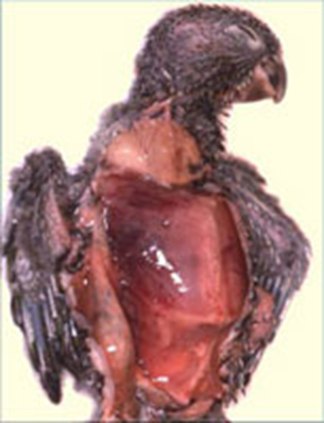Long Pham

Avian polyomavirus in birds poses a significant concern for caged birds, leading to substantial economic losses for pet retailers and bird enthusiasts. Initially identified in budgerigars during the early 1980s in Ontario, Canada and in the southern regions of the United States, it was initially termed Budgerigar Fledgling Disease Virus. This nonenveloped DNA virus belongs to a single genus Polyomavirus in the family Polyomaviridae. Further research revealed its ability to infect various species of psittacine birds, leading to its designation as avian polyomavirus. Avian polyomavirus is widespread, affecting psittacine birds in numerous countries, making it a notable concern in aviculture.
Transmission
Polyomavirus is typically transmitted through direct contact with infected birds. Additionally, transmission can occur through contact with contaminated feces, dander, air, nest boxes, incubators, feather dust, or from infected parent birds passing it to their chicks.
Clinical signs
Young birds, ranging from newborns to juveniles (14-56 days), are particularly vulnerable to polyomavirus infection, which is often fatal. Following infection, it typically takes 10-14 days for birds to display symptoms. However, some birds may remain asymptomatic. If symptoms do appear, the bird’s death may be imminent, often occurring within one or two days. The virus compromises the bird’s immune system, making it susceptible to other pathogens such as viruses, bacteria, fungi, and parasites, leading to secondary infections and eventual demise.
Common symptoms of polyomavirus infection in birds include lethargy, regurgitation, cutaneous hemorrhage, abdominal distention, excessive urination, diarrhea, tremors, and feather abnormalities.
Diagnosis
The typical antemortem diagnosis involves using PCR on cloacal swabs, blood samples, and affected feather samples. It also includes conducting virus-neutralizing antibody tests on blood samples to identify birds that have previously been exposed to the virus. In a flock setting, diagnosis is commonly based on clinical observations, the characteristics of the affected birds, and findings from necropsies.
Treatment and Prevention
Aviary management strategies include avoiding housing budgerigars or lovebirds with other species, maintaining strict hygiene protocols, restricting access to the nursery, and enforcing a 90-day quarantine with testing before introducing new birds. Removing Avian Polyomavirus (APV) from an infected budgerigar aviary is complex and involves stopping breeding for six months. During this period, infected neonates, fledglings, and adult birds must be isolated while the aviary undergoes thorough disinfection. Nest boxes should be disinfected or replaced. After six months, breeding can resume in a sanitized environment.
Preventive measures for pet stores include separating neonates from different sources, sourcing birds from facilities conducting polyomavirus testing and vaccination, and ideally avoiding transactions involving unweaned birds.
References
- Bernier, G., M. Morin, and G. Marsolais. 1981. A generalized inclusion body disease in the Budgerigar (melopsittacus undulatus) caused by a papovavirus-like agent. Avian Diseases 25:1083-1092.
- Latimer, K. S., F. D. Niagro, R. P. Campagnoli, B. W. Ritchie, D. A. Pesti, and W. L. Steffens. 1993. Diagnosis of concurrent avian polyomavirus and psittacine beak and feather disease virus infections using DNA probes. Journal of the Association of Avian Veterinarians 7:141–146.
- Samanta, I., and S. Bandyopadhyay. 2017. Infectious diseases. Pet bird diseases and care 13–166.

